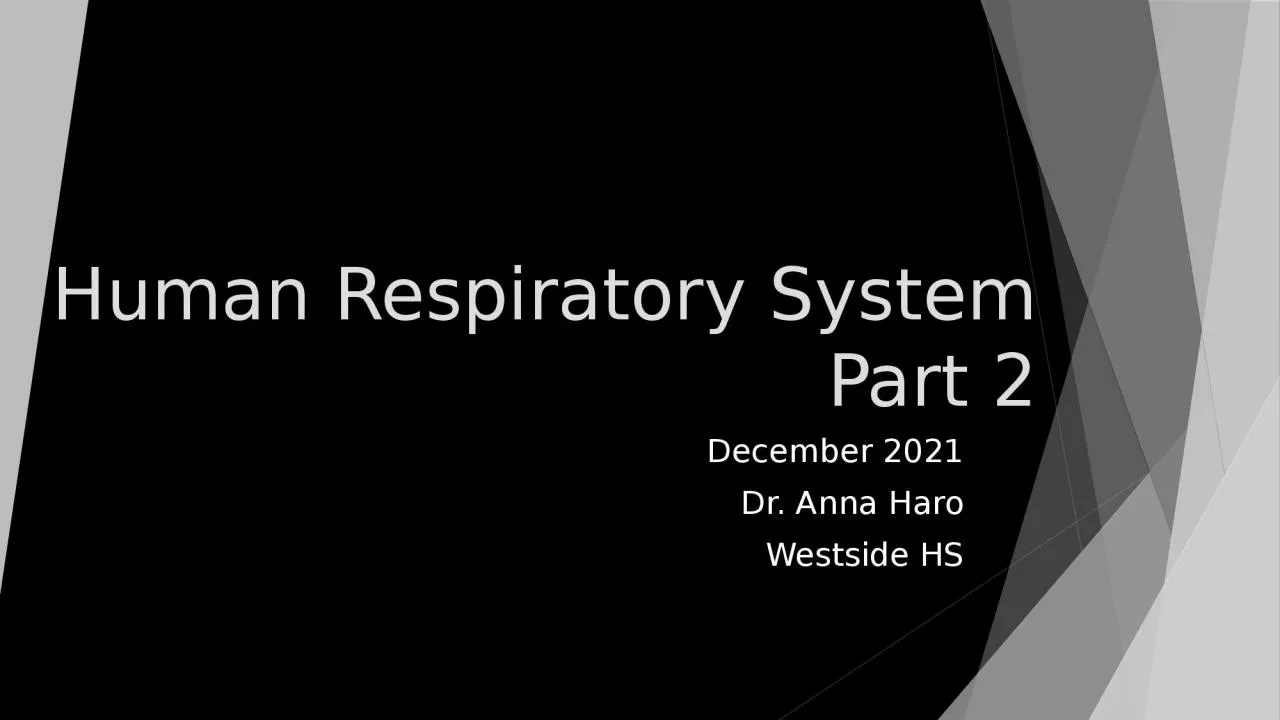

Part 2 December 2021 Dr Anna Haro Westside HS LEARNING Objectives TEKS 130231 c 1A amp B and 130231 c 2A B C F amp G amp 3B Students will apply knowledge of human and cellular biology ID: 931285
Download Presentation The PPT/PDF document "Human Respiratory System" is the property of its rightful owner. Permission is granted to download and print the materials on this web site for personal, non-commercial use only, and to display it on your personal computer provided you do not modify the materials and that you retain all copyright notices contained in the materials. By downloading content from our website, you accept the terms of this agreement.
Slide1
Human Respiratory SystemPart 2
December 2021
Dr. Anna Haro
Westside HS
Slide2LEARNING Objectives
TEKS:
§130.231.(c)(1)(A, & B) and §130.231.(c)(2)(A, B, C, F, & G) & (3)(B)
Students will apply knowledge of human and cellular biology.
Students will develop knowledge of the anatomy and physiology of the human respiratory system.
Students will compare the different parts of the airways.
Students will evaluate the parts and function of the bronchial tree.
Slide3Objetivos de aprendizaje
TEKS: §130.231.(c)(1)(A, & B) and §130.231.(c)(2)(A, B, C, F, & G) & (3)(B)
Los estudiantes aplicarán conocimientos de biología humana y celular.
Los estudiantes desarrollarán el conocimiento de la anatomía y fisiología del sistema respiratorio humano.
Los estudiantes compararán las diferentes partes de las vías respiratorias.Los estudiantes evaluarán las partes y la función del árbol bronquial.
.
Slide4Human respiratory system
The main function of the human respiratory system is gas-______________. Respiratory events include:
The movement of air in and out of the lungs, commonly called breathing or ventilation.
The exchange of gas between the lungs and blood (
external respiration
).The exchange of gases between the blood and body cells (internal respiration).The oxygen utilization and CO2 production (
cellular respiration).
Slide5Other physiologic functions of the Respiratory System
The respiratory system:
Allows the patient to talk and to _______________.Warms air to match the body temperature and moisturizes it to the humidity level the body needs._______________ the airways from harmful substances and irritants.
Respiration is both macroscopic and microscopic – explain what this means.
Slide6Human Respiratory System
Image from:
https://www.howtorelief.com/respiratory-system-parts-function/
Which lung is larger and why?
Slide7What is the anatomy of the human respiratory system?
Many different components (organs and tissues) comprise the respiratory system. Start with t
he airways: Mouth and nose: Openings that pull air from outside your body into your respiratory system. Internal hairs in the nostrils begin to ______________ inhaled
air.
Nasal cavity is the hollow space behind the nose. This transports air to the pharynx, and the mucous lining helps to filter, warm, and moisten the incoming air.
Sinuses: Hollow areas between the bones in your head that help regulate the temperature and humidity of the air you inhale. Also reduces the weight of the skull and adds resonance to voice.
Pharynx (throat): Tube that delivers air from your mouth and nose to the trachea (windpipe), which distinguishes air from food/drink entering your esophagus. Located ___________ to the oral cavity and __________ the nasal cavity and larynx.
Slide8What is the anatomy of the human respiratory system?
Larynx: this is the “
voicebox” and is an enlarged area superior to the trachea. It is the passageway for air and prevents foreign material from entering the lungs and contains the vocal cords.Trachea or the “windpipe”:
Flexible tube and passageway connecting your throat and lungs, specifically the larynx to the _____________ tree.
Bronchial tree: Beginning with the bronchial tubes, located at the bottom of your trachea, connecting into the branches of each lung and leading to the alveoli.
Lungs: The soft, cone-shaped organs occupying the thoracic cavity (along with the heart), which remove oxygen from air and pass it into your bloodstream. The lungs contain the bronchial tree, the alveoli, blood vessels, connective tissue, lymphatic vessels, and the nerves of the lower respiratory tract.
Slide9The bronchial tree
The bronchial tree is the respiratory structure which delivers external air from the trachea to the microscopic air sacs (alveoli) within the lungs where gas exchange and diffusion begins.
The trachea – this is the “trunk” of the tree where the two main branches first diverge at the carina.The primary left bronchus and the primary right bronchus are the two main branches leading to the left and right lung respectively. Note, the right primary bronchus is more vertical vs. the horizontal position of the left.The secondary (right) lobar bronchi and the secondary (left) lobar bronchi branch off from the primary into the right and left lobes respectively. There are __________ secondary right lobar bronchi and __________ secondary left lobar bronchi.
One bronchus ends in “us” if more than one, then they are bronchi.
Slide10The bronchial tree
The third level are the tertiary segmental bronchi. There are usually ten bronchial segments in the right lung and eight in the left lung.
The next level are the intralobular bronchioles, and these are the much smaller branches, also called the bronchioles or lobules.The fifth level are the terminal bronchioles, with approximately 50 (left) to 80 (right) terminal bronchioles in the lobule of each lung.The sixth level are the respiratory bronchioles with two branching off from each terminal bronchiole.Then, about 2 to 10 alveolar ducts branch from the respiratory bronchioles.
Slide11The bronchial tree
The 8
th
level are the alveolar sacs – these are thin-walled and closely-packed
outpouches
of the alveolar ducts.
Finally, the alveolus or many alveoli are thin-walled, and microscopic air sacs that open to an alveolar sac. Air can diffuse freely from the duct to the sac to the alveoli.
Image from:
https://study.com/academy/lesson/alveolar-ducts-function-definition.html
Slide12What are your questions about the respiratory system?
Please ask, email, use Remind, or TEAMS.
Remember the HON-code? https://www.hon.ch/HONcode/. Even if you cannot find the HON-code stamp, please use the principles of website evaluation.Authority, confidentiality, complementary, attribution, justification, transparency, financial disclosure, and advertising policy (HON-code, 2019).
Slide13References
https://my.clevelandclinic.org/health/articles/21205-respiratory-system
https://www.howtorelief.com/respiratory-system-parts-function/
Shier D, Butler J, Lewis R.
Hole’s Human Anatomy and Physiology
, 9th edition. 2003.
https://study.com/academy/lesson/alveolar-ducts-function-definition.html